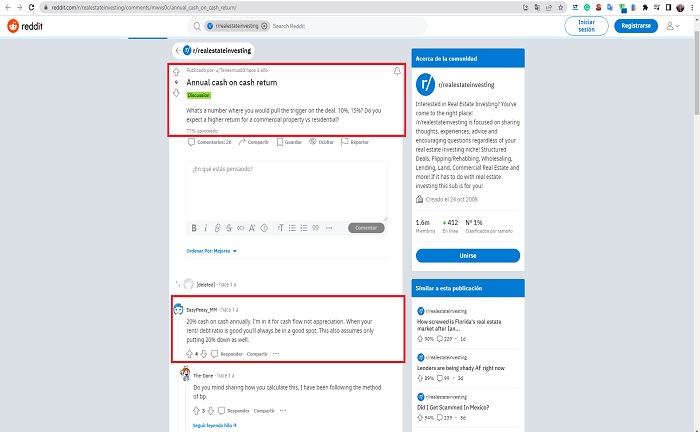Accounting is necessary for virtually any field. And when it comes to real estate, it is even more so. For this, many accounting parameters are used; among them, one of the most important is the return of cash versus cash.
Due to the existence of similar concepts, it is not always fully understood what cash versus cash is and how it is calculated, although these are simple aspects.
What is cash versus cash return?
Cash versus cash return is an accounting parameter that evaluates the differential between the cash invested in a property and the cash return of this property within one year.
Although it is an accurate formula, it is often used to determine whether buying or renting a property is profitable rather than whether the rental has been performing as expected.
Most of the time, it is used as a metric to calculate if it is worthwhile because its variables are quite general and are not considered sufficient to determine whether an investment has been truly profitable.
Its variables exclude several values that should be considered to calculate the precise profitability of an accurate real estate investment.
It is an ideal calculation to estimate whether a property might be profitable depending on the amount of money likely to come in and the amount of capital invested.
It is normal for investors to perform it several times in a very short time while visualizing the characteristics of various properties they could acquire for rental purposes.
Investors analyze how much capital they will need to invest in starting renting the property and how much income it could generate over a year to determine if it is a worthwhile option.
What variables make up the cash-on-cash return?
To calculate cash on cash return, we need to consider two values: Annual Net Cash Flow and Invested Capital.
Annual net cash flow
The difference between a given investment’s cash inflow and outflow within one year is called annual net cash flow. In particular, it refers to the amount of total gross income minus the number of total expenses.
The annual net cash flow plays a fundamental role in the cash versus cash return calculation because it defines how much money has remained positive or negative in the investment during that period.
Invested capital
Invested capital is all the cash initially put into operating the property and keeping it in production. Sometimes, invested capital can refer to any operation where investment is needed.
But, in particular, calculating cash-on-cash return refers to all the cash necessary to put the return on investment in place. Generally, it relates to what was invested in initiating the property as a rental.
How to calculate cash on cash return?
The formula for calculating cash-on-cash return is simple. It is done by dividing the annual net cash flow by the invested capital. Leaving the procedure as follows:
- Cash vs. cash return = Annual net cash flow/invested capital
Most probably, the result of that operation will be a rather low number. This number in the form of a percentage may not be very understandable and applicable. To make it consistent, multiply the resulting number by 100.
The final result is obtained in percentage form, as it references the percentage of profit for that particular year concerning all cash capital invested in starting operations.

This formula uses debt as part of the calculation. Thus, investors can get a broader view of everything, including the financing value expense. In cases where no financing is applied, the cost is considered part of the invested capital.
Here is an example
To make it more practical, let’s imagine an investor determined to buy a property for $100,000. In addition to the $100,000, he must spend $20,000 on repairs to be able to rent the property at a higher price.
The purchase was made in cash and not through the acquisition of debt. In addition, we must assume annual earnings of about $15,000 in net cash flow.
Then, we must take the $15,000 and divide it by the $120,000 invested in equity; the result will be multiplied by 100. As a result, we will have a 12.5% cash return versus cash for that year.
It would help if you changed the cash flow parameter when you perform the cash versus cash account in a shorter or longer year.
That is, if you would like to obtain the return of cash against cash for three months, you should make the account with the net cash flow according to 3 months. The same applies to any other period.


